Jazz Piano Chords - Adding the Raised or Lowered 9th, 11th, 13th Notes
Home » Piano Chords » Jazz Piano Chords - Adding the Raised or Lowered 9th, 11th, 13th
The next step in our jazz lessons is to learn to form jazz piano chords with a raised or lowered 9th, 11th, and 13th. Once we cover that issue we will be able to play s variety of jazz chord progressions which I'm going to show you in the next lesson.
In this lesson I'm going to show you what's a raised or lowered note is, then we're going to add it to a seventh chord in the II-V-I chord progression and last but not least we're going to understand how use this chord in practice by understanding how it functions in jazz standards.
In other words we're going to see which piano scale could be played when we play this jazz piano chord in a chord progression which will help us improvise with it later.
Let's start with the lowered ninth.
The Lowered Ninth in Jazz Piano Chords
In order to lower the ninth note of a chord all we have to do is lower the ninth chord in half a tone. The chord which we're going to play after omitting the root note from the bottom of the chord since it create an octave with the bass is this:
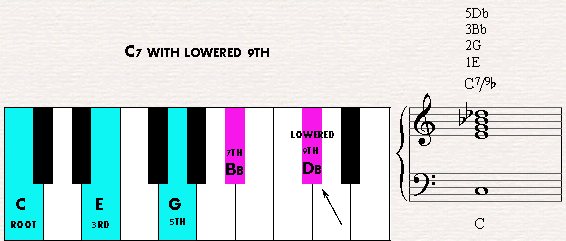
Listen to sound of the chord. It sounds quite intense.
The reason this chord sounds so intense is because of the flat 9th interval created between
the bass and the lowered 9th which is as we've learn when we added the 11th chord, the most intense interval in western music.
When we played an eleventh chord we said we won't play this interval since it is too strong clashing with the 3rd note so cleary. Here the case is different. Let's see why…
Lowered 9th chords appear often in jazz music in II-V-I progression as dominant or secondary dominant chords.
The function of dominant chord in music is to create tension toward the tonic. When we play a lowered 9th dominant chord (Db in our case in G7 since we take a II-V-I in C major for example) we create a very intense tension toward the tonic.
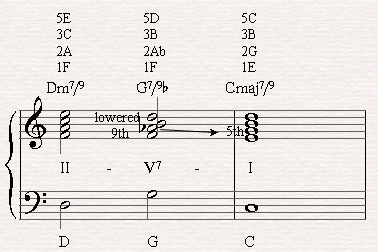
If we look at the voice leading in this case we'll see that lowered 9th is solved to the fifth note (G)
in the tonic chromatically. The chromatic movement in music is known for its intense and dramatic effect.
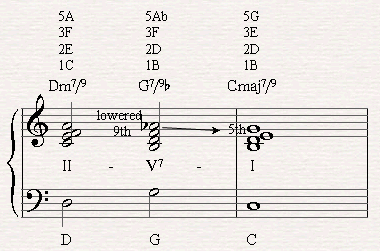 Play Audio
Play Audio
Here is the same chord progression in the other common chord progression.
(We like to have the 3rd or the 7th in the bottom of the chord remember?
Now we only have to understand where this note derives from scale wise speaking. Until today we took the extension from the major or minor scale. Where does the lowered 9th derive from?
Well, as a matter of fact two scales are possible. The first scale is the Octatonic scale (Click here to read about the Octatonic scale-coming soon).
The Lowered 9th in the Octatonic Scale
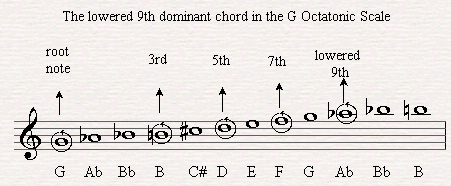 A jazz piano chord with only a seventh and a lowered 9th deriving from the octatonic scale would be built in this way.
A jazz piano chord with only a seventh and a lowered 9th deriving from the octatonic scale would be built in this way.However, When we clearly want to state the source of our lowered 9th jazz piano chord we're going to add the thirteenth note of the note to the chord. We'll cover that issue in a moment.
Before that such a question might have appeared in your mind... "Well, you said that I would play the lowered 9th chord when I know I have to participate the Octatonic or altered scale in playing, but how do I know I have to combine one of these scales in playing?"
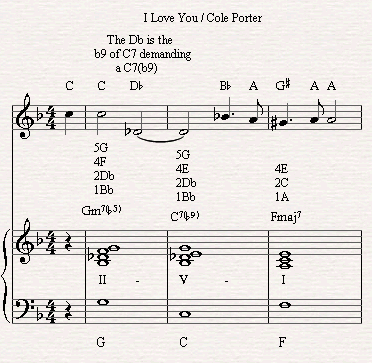
Here's an example of a song that demands the playing of a lowered 9th jazz piano chord since
its melody involves that note. It's called "I Love You" by the wonderful Cole Porter.
Adding the 13th Note to lowered 9th Chord in the Octatonic Scale
Now we're going to add the 13th note of the chord to the lowered 9th jazz piano chord in order to be clear as for which scale the chord derive from so we would know what kind of scale we're expected to improvise with.
Let's start with the natural 13th which let us know that we're expected to play the Octatonic scale since it is present as part of it.
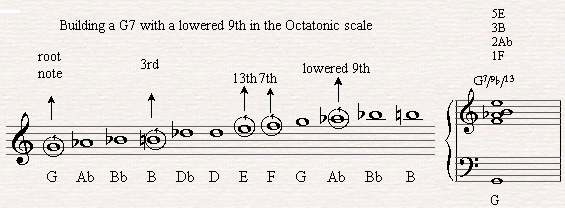
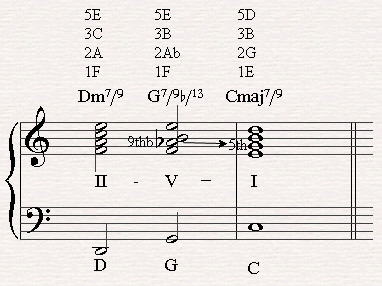
Here's how the II-V-I chord progression will look like with a G7/b9/13 in C major.
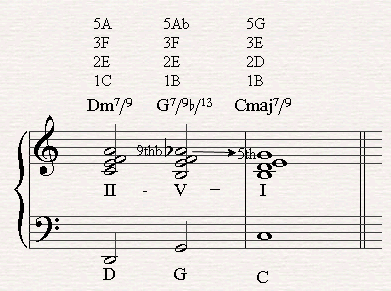
And here it is again in the 2nd common inversion.
Adding the Lowered 13th to to Lowered 9th Jazz Piano Chords in the Altered Scale
If the b9th chord derives from the altered scale we will lower the 13th in half a tone as the scale demands and play the lowered 13th as follows
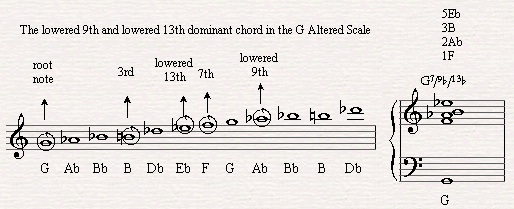
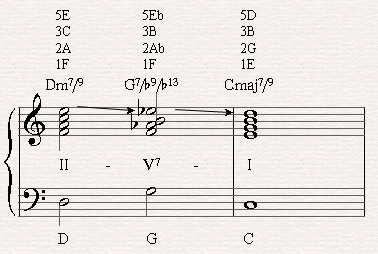
Here's a II-V-I chord progression leading to C major with a G7/b9/b13.
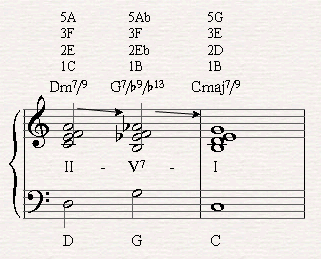
And here's the second common inversion.
Now let's explore new possibilities with the raise 9th in jazz piano chords.
The Raised 9th or Lowered 10th in Jazz Piano Chords
The raised 9th or as it often called the lowered 10th is often played in secondary dominants chords in both the Octatonic and the altered scales. In our case we'll us the raised 9th in the second degree after we substitue it with the secondary dominant of G7.
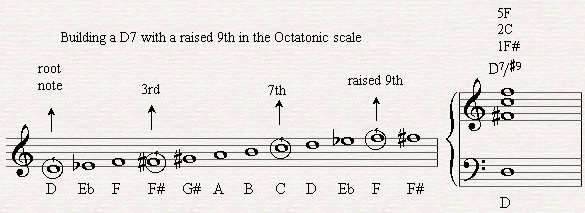
Notice that we omit the fifth from the chord to give it some space.
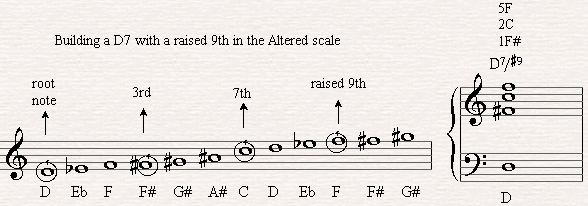 The results of both scale are equal since both contain the raised ninth.
The results of both scale are equal since both contain the raised ninth. 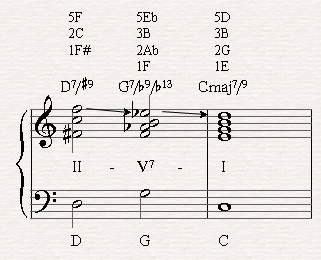
When should we use this alteration?
Well, when we choose to play the raised 9th we make a melodic Line stepping beuatifully from the
secondary dominant through the dominant and down to the tonic.
If we'll look at the voice leading we'll see that the raised 9th is being solved
to the fifth note of the tonic as well in both cases.
Although both option are possible we tend to use the altered option more
since it creates unity of sound between the II and the V.
The Raised 11th in Jazz Piano Chords
The raise 11th is being added as an extension very often to the tonic in the final chord of the piece. Jazz singers like to finish their melodic lines with this extension to create a jazz effect and then you as a piano player are expected to support them by playing the raised eleventh chord.
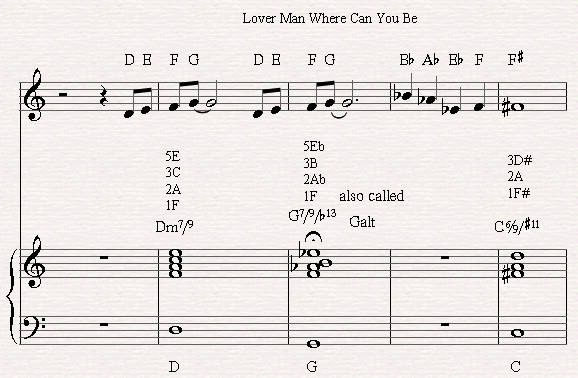
Here's a good example of such an example in song "Lover Man" by R.Ramirez and J.Davis as performed by the lovely Sarah Vaughn.
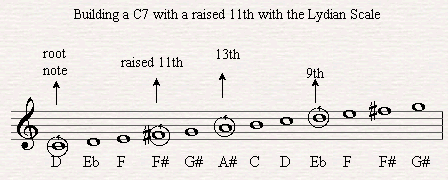 Which scale does this note derive from?
Which scale does this note derive from?
This time we would use the lydian scale who has a raised 11th.
Now when I played the tonic in this situation I omitted the 3rd from the chord.
Quite a strange thing to do isn't it?
Yep, I agree but the fact is that the ear expects the 3rd so clearly that omitting it in favor of the raised 11th sound quite natural.
More so, since there are already enough extenions in the chord
we can say the we play the chord in its upper structure.
 Playing Jazz piano chords is like speaking a language. You should be familiar with the concept of coloring a chord in a way that fits the medium.
Once you do that you have to learn to combine the harmony with quite complicated rhytmical patterns which could be a problem.
Playing Jazz piano chords is like speaking a language. You should be familiar with the concept of coloring a chord in a way that fits the medium.
Once you do that you have to learn to combine the harmony with quite complicated rhytmical patterns which could be a problem.
James Wrubel, an amazing musician and expert instructor. He's been there and back as a professional jazz musician and has played with some of the top names in the industry.
In two dvds and over 2 hours of step-by-step instruction, he takes you by the hand and shows you how to master tons of jazz & blues tricks and techniques as well as signature soloing secrets that'll have you sounding like you've been playing for years.
Click here to check out the Hear & Play Jazz 101 course!













